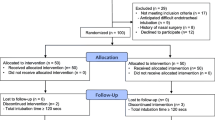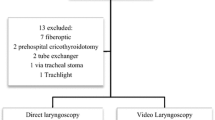Abstract
Airway management in patients with ankylosing spondylitis (AS) is a challenging problem for anesthesiologists. The GlideScope video laryngoscope (GVL) is designed to assist tracheal intubation for patients with a difficult airway. The aim of the study was to report the successful intubation by GVL of four AS patients, and to discuss the use of GVL for tracheal intubation in patients with AS by performing a review of the literature. Four patients with chronic, severe AS were evaluated preoperatively; all had features associated with a difficult direct laryngoscopy. We performed the necessary preparations for difficult airway and intubation. Patients were kept in supine position, with their head and neck supported on pillows. Following sufficient preoxygenation, patients received i.v. remifentanil at 1 μg kg−1, propofol at 2 mg kg−1, and succinylcholine at 1 mg kg−1. GVL intubation was provided after full muscle relaxation. GVL is reasonable alternative to awake fiberoptic bronchoscopy or any other device, as it appears that less training and skill is involved in the actual intubation process. Adequate laryngeal exposure was obtained in all patients were successfully intubated in the first attempt. As with any challenging airway management, it is essential to have a rescue strategy. We believe that GVL can be a good alternative for oral endotracheal intubation in patients with AS. This series is very small and the reader should be very cautious about drawing broad conclusions regarding the GVL and patients with AS.

Similar content being viewed by others
References
Oliveira CRD. Ankylosing spondylitis and anesthesia. Rev Artic Rev Bras Anestesiol. 2007;57(2):214–22.
Woodward LJ, Kam PCA. Ankylosing spondylitis: recent developments and anaesthetic implications. Anaesthesia. 2009;64:540–8.
Niforopoulou P, Pantazopoulos I, Demestiha T, Koudouna E, Xanthos T. Video-laryngoscopes in the adult airway management: a topical review of the literature. Acta Anaesthesiol Scand. 2010;54:1050–61.
Griesdale DEG, Liu D, McKinney J, Choi PT. Glidescope® video-laryngoscopy versus direct laryngoscopy for endotracheal intubation: a systematic review and meta-analysis. J Can Anesth. 2012;59:41–52.
Andersen LH, Rovsing L, Olsen KS. GlideScope videolaryngoscope vs. macintosh direct laryngoscope for intubation of morbidly obese patients:a randomized trial. Acta Anaesthesiol Scand. 2011;55:1090–7.
Serocki G, Bein B, Scholz J, Dörges V. Management of the predicted difficult airway: a comparison of conventional blade laryngoscopy with video-assisted blade laryngoscopy and the GlideScope. Eur J Anaesthesiol. 2010;27:24–30.
Cooper RM, Pacey JA, Bishop MJ, McCluskey SA. Early clinical experience with a new videolaryngoscope (GlideScope) in 728 patients. Can J Anaesth. 2005;52:191–8.
Mashour GA, Kheterpal S, Vanaharam V, Shanks A, Wang LY, Sandberg WS, Tremper KK. The extended Mallampati score and a diagnosis of diabetes mellitus are predictors of difficult laryngoscopy in the morbidly obese. Anesth Analg. 2008;107(6):1919–23.
Levitan RM, Ochroch EA, Kush S, Shofer FS, Hollander JE. Assessment of airway visualization: validation of the percentage of glottic opening (POGO) scale. Acad Emerg Med. 1998;5(9):919–23.
Lu PPL, Brimacombe J, Ho ACY, Shyr MH, Liu HP. The intubating laryngeal mask airway in severe ankylosing spondylitis. Can J Anaesth. 2001;48:1015–9.
Lai HY, Chen IH, Chen A, Hwang FY, Lee Y. The use of the GlideScope for tracheal intubation in patients with ankylosing spondylitis. Br J Anaesth. 2006;97:419–22.
Huang SJ, Lee CL, Wang PO, Lin PC, Lai HY. The use of the GlideScope® for tracheal intubation in patients with halo vest. Acta Anaesthesiol Taiwan. 2011;49:88–90.
Gunaydin B, Gungor I, Yigit N, Celebi H. The Glidescope for tracheal intubation inpatients with ankylosing spondylitis. Br J Anesth. 2007;98(3):408–9.
Wang PK, Luo PH, Chen A, Chen TY, Lai HY. Emergency tracheal intubation in an ankylosing Spondylitis patient in the lateral position using the GlideScope. Acta Anaesthesiol Taiwan. 2008;46(2):80–1.
Gooden CK. Successful first time use of the portable GlideScope® videolaryngoscope in a patient with severe ankylosing spondylitis. Can J Anaesth. 2005;52(7):777–8.
Conflict of interest
The authors have no conflict of interest.
Author information
Authors and Affiliations
Corresponding author
Rights and permissions
About this article
Cite this article
Saricicek, V., Mizrak, A., Gul, R. et al. GlideScope video laryngoscopy use tracheal intubation in patients with ankylosing spondylitis: a series of four cases and literature review. J Clin Monit Comput 28, 169–172 (2014). https://doi.org/10.1007/s10877-013-9511-0
Received:
Accepted:
Published:
Issue Date:
DOI: https://doi.org/10.1007/s10877-013-9511-0




